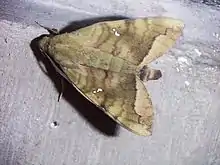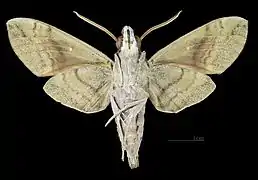Nephele hespera
Nephele hespera, the crepuscular hawkmoth, is a sphingid moth described by Johan Christian Fabricius in 1775.
| Crepuscular hawkmoth | |
|---|---|
 | |
| Scientific classification | |
| Kingdom: | |
| Phylum: | |
| Class: | |
| Order: | |
| Family: | |
| Genus: | |
| Species: | N. hespera |
| Binomial name | |
| Nephele hespera (Fabricius, 1775) | |
| Synonyms | |
| |
Distribution
It is found in the tropical and subtropical forests of Sri Lanka, India, Nepal, Myanmar Myanmar, southern China, Thailand, Vietnam, Malaysia and Indonesia.
Description
The wingspan is 70–86 mm. The silver markings on the wings can be present or absent in both sexes. It differs from nearly all other Nephele species in the apical hind tibial spurs having only a few, rather thin, distally situated spines. The hind basitarsal comb is less developed than in African species of Nephele.[1]
Head, thorax and abdomen olive brown or green. Abdomen is with lateral black segmental bands. Forewings are olive brown or green, with six faint waved lines and an angled submarginal line. The space between it and outer margin is paler. At the end of the cell, there are two conspicuous silvery-white spots, which may be reduced to a small speck or be altogether obsolete. Hindwings are reddish brown and cilia are ochreous. Ventral side is paler, each wing with two transverse lines. Larva is greenish with a pale stripe from 7th to 11th somites.[2]
 Male dorsal view
Male dorsal view Male ventral view
Male ventral view Female dorsal view
Female dorsal view Female ventral view
Female ventral view
Biology
The larvae feed on Carissa congesta. Pupa is bone yellow in color. The moth rests with the wings held horizontal and the tip of the abdomen slightly upturned.[3]
References
- "Nephele hespera". Butterfly House. Retrieved 6 July 2016.
- Hampson, G. F. (1892). The Fauna of British India, Including Ceylon and Burma: Moths Volume I. Taylor and Francis – via Biodiversity Heritage Library.
- Pittaway, A. R.; Kitching, I. J. (2018). "Nephele hespera (Fabricius, 1775) -- Crepuscular hawkmoth". Sphingidae of the Eastern Palaearctic. Retrieved December 16, 2018.